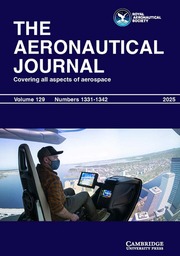No CrossRef data available.
Article contents
Preliminary investigation of the superelastic monostable spoiler for dynamic gust loads alleviation
Published online by Cambridge University Press: 02 October 2025
Abstract
This paper provides a preliminary investigation into the use of a novel passive aircraft flight loads alleviation device called the Superelastic Monostable Spoiler. The work focuses primarily on understanding the behaviour of such a device and the related loads alleviation performance during dynamic gust events. A number of different design parameters are explored, such as the trigger condition and the activation speed. The main aim of the paper is to define the preliminary operational requirements of such a device in order to guide the future detailed design, which is not addressed here. It was found that the Superelastic Monostable Spoiler could potentially provide loads alleviation performance comparable with typical gust loads alleviation technologies currently used in modern civil aviation based on the use of ailerons and spoilers.
Information
- Type
- Research Article
- Information
- Copyright
- © The Author(s), 2025. Published by Cambridge University Press on behalf of Royal Aeronautical Society


